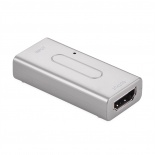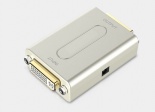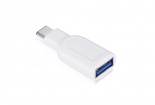 FAQ
FAQ
Q: Что такое eSATAp(или питание от eSATA)?
In computing, eSATAp (also known as Power over eSATA, Power eSATA, eSATA/USB Combo, eSATA USB Hybrid Port (EUHP)) is a combination connection for external storage devices. A single eSATAp, eSATA or USB device can be plugged into an eSATAp port. The socket has keyed cutouts for both types of device to ensure that a connector can only be plugged in the right way round.Standard
As the port is designed to work with both SATA and USB, neither organization has formally approved it. USB-IF states it does not support any connector used by other standards, these combo ports are to be used at your own risk, and SATA-IO(Serial ATA International Organisation), the organization responsible for the SATA specification, is as of 2011, working to define the eSATAp specification.
Implementation
SATA is a computer bus interface for connecting host bus adapters to mass storage devices such as hard disk drives andoptical drives. eSATA is a SATA connector accessible from outside the computer, to provide a signal (but not power) connection for external storage devices.
eSATAp combines the functionality of an eSATA and a USB port, and a source of power in a single connector. eSATAp can supply power at 5 V and 12 V.
On a desktop computer the port is simply a connector, usually mounted on a bracket at the back accessible from outside the machine, connected to motherboardsources of SATA, USB, and power at 5 V and 12 V. No change is required to drivers, registry or BIOS settings and the USB support is independent of the SATA connection.
If advanced functionality such as a port multiplier is required, a PCI Express add-on card can be used. If it has port multiplier support, an eSATAp port allows a user to connect to a multi-bay NAS (network attached storage) machine with multiple hard disks (HDD) using one eSATA cable.
On many notebook computers only a limited amount of power at 5 V is available, and none at all at 12 V. Devices requiring more power than is available via the Expresscard, or an additional 12 V supply as required by most 3.5" or 5.25" drives, can be driven if an additional power supply is used. Cables are available to both connect and power a SATA device from an eSATAp port (including 12V power if available)
Compatibility
eSATAp throughput is necessarily the same as SATA, and USB throughput is that of the USB version supported by the port (typically USB 3.0 or 2.0). eSATAp ports (bracket versions) can run at a theoretical maximum of 6 Gbit/s (bits per sec) and are backwards compatible with devices such as eSATA 3 Gbit/s (SATA Revision 2) and also at 1.5 Gbit/s (SATA Revision 1). The USB port is fully compatible with USB 5 Gbit/s (USB 3.0), USB 480 Mbit/s (USB 2.0) and USB 12 Mbit/s (1.1); USB 3.0 devices are compatible, but will operate at USB 2.0 speed if internal USB 3.0 connector is not connected.
Q: В чём разница между “Standard” HDMI кабелем и “High-Speed” HDMI кабелем?
Недавно компания HDMI Licensing, LLC объявила, что кабели следует определять как стандартные(Standard) или высокоскоростные (High-Speed)кабели.HDMI кабели Standard (или категория 1) прошли испытания для работы на скорости от 75 МГц и до2,25 Гбит/с, что является эквивалентным корректной работе с разрешением 720р/1080i.
HDMI кабели High Speed (или категория 2) были протестированы для работы на скорости от 340Mhz до 18 Гбит / с, которая является самой высокой пропускной способности в настоящее время доступной для кабелей HDMI, и может успешно обрабатывать сигналы разрешения 1080р, в том числе при повышенной глубиной цвета и/или повышенной частоте обновления от источника. Высокоскоростные кабели также поддерживают более высокое разрешение дисплеев, что способствует безупречной передаче мельчайших деталей кино (разрешение 4K (3840х2160) при 50/60 Гц, что в 4 раза четче 1080p@60).
Q: Какие продукты могут поддерживать MHL
Silicon Image анонсировала семейство чипов, поддерживающих MHL включая передатчик, мост и процессор порта.
MHL (Mobile High-Definition Link) — стандарт мобильного аудио-видео интерфейса, объединяющий в себе функциональность интерфейсов HDMI и MicroUSB, служащий для непосредственного подключения мобильных устройств к телевизорам и мониторам, поддерживающим высокое разрешение Full HD. Разъем стандарта MHL поддерживает передачу видео высокого разрешения.
Стандарт MHL был разработан в середине 2010 г. консорциумом, в состав которого вошли компании Nokia, Toshiba и Sony.
Устройства, поддерживающие стандарт MHL:
Acer
CloudMobil
Alcatel
ONE TOUCH 997
ONE TOUCH 997A
ONE TOUCH 997D
ONE TOUCH 998
S800
Asus
Padfone 2
Fujitsu
201F
A 301F
ARROWS A 101F
ARROWS X F-10D
ARROWS Z F-10D
ARROWS Z ISW13F
EM01F
F-01F
F-02F
F-03F
F-06E
FJL22
FJT21
M702
REGZA Phone T-02D
HTC
Amaze 4G
Butterfly
Butterfly S
Droid DNA
EVO 3D
EVO 4G LTE
EVO View 4G
Flyer
HTC One M8
HTC One Max
J ISW13HT
Jetstream
One
One S
One X
One X+
One XL
Raider
Rezound
Sensation
Sensation 4G
Sensation XE
Velocity
Vivid
Huawei
Ascend D Quad
Ascend D1
Ascend D1 Quad
Ascend D1 Quad XL
Ascend D2
Ascend P1
Ascend P1 S
Ascend P2
D2-6114
Huawei MediaPad 7 (S10-102L, S10-103L) Lite Android Tablet
HW-03E
Mediapad M1 8.0 (403HW)
P6 S-L01
P6 S-U06
S10-231L
S7-951wd
S7-961w
U9200
Kyocera
KLY22
KYL21
KYY21
KYY22
WX10K
LG
Nitro HD
Optimus 3D Max
Optimus 4X HD
Optimus G (LG-F180L)
Optimus GJ (LG-E975W)
Optimus LTE II
Optimus LTE Tag
Optimus Vu
Prada
Verizon Spectrum
Meizu
MX
MX 2
NEC Casio
Media X N-06E
OPPO
Find 3
Panasonic
Eluga P P-03E
Pantech
Vega LTE
Samsung
AT&T Galaxy Note LTE 5.3"
AT&T Galaxy S II (i777)
AT&T Galaxy S II Skyrocket Note (i727)
AT&T Galaxy S III (i747 - требуется адаптер MHL 5pin > 11pin)
Captivate Glide (i927)
Cricket Galaxy S III (SCH-R530C - требуется адаптер MHL 5pin > 11pin)
Epic 4G Touch
Galaxy Express (требуется адаптер MHL 5pin > 11pin)
Galaxy K Zoom (SM-C1150WAEUR - требуется адаптер MHL 5pin > 11pin)
Galaxy Mega 6.3 and 5.8 (требуется адаптер MHL 5pin > 11pin)
Galaxy Nexus (i9250)
Galaxy Nexus 2
Galaxy Note 3 (требуется адаптер MHL 5pin > 11pin)
Galaxy Note 3 Neo (SM-N750K, SM-N750L, SM-N750S)
Galaxy Note 4 (SM-N916S, SM-N910A)
Galaxy Note 5.3"
Galaxy Note 8 (GT-N5100, GT-N5105, GT-N5120 - требуется адаптер MHL 5pin > 11pin)
Galaxy Note Edge (SM-G906C)
Galaxy Note II (требуется адаптер MHL 5pin > 11pin)
Galaxy Note Pro (требуется адаптер MHL 5pin > 11pin)
Galaxy S II (i9100, GT-I9100)
Galaxy S III (i9300, SCH-R530X - требуется адаптер MHL 5pin > 11pin)
Galaxy S4 (GT-I9500, GT-I9505 - требуется адаптер MHL 5pin > 11pin)
Galaxy S4 TD-LTE (GT-I9507, GT-I9506 - требуется адаптер MHL 5pin > 11pin)
Galaxy S5 (SM-G900A, SM-G900D, SM-G900FQ, SM-G900I, SM-G900J, SM-G900K, SM-G900L, SM-G900M, SM-G900P, SM-G900R4, SM-G900R6, SM-G900R7, SM-G900S, SM-G900T, SM-G900T1, SM-G900V, SM-G900W8 - требуется адаптер MHL 5pin > 11pin)
Galaxy S5 Dual Sim (SM-G9009D, SM-G9008V, SM-G9008W, SM-G9006V, SM-G9006W, SM-G9009W - требуется адаптер MHL 5pin > 11pin)
Galaxy S5 Zoom (SM-C115L, SM-C115S, SM-C115K - требуется адаптер MHL 5pin > 11pin)
Galaxy Tab 3 8", 10.1" (GT-P5210 - требуется адаптер MHL 5pin > 11pin)
Galaxy Tab S 10.5" (SM-T807T, SM-T805, SM-T800, SM-T807A, SM-T805W, SM-T805Y, SM-T805M, SM-T805C - требуется адаптер MHL 5pin > 11pin)
Galaxy Tab S 8.4" (SM-T707V - требуется адаптер MHL 5pin > 11pin)
Galaxy TabPRO 10.1" (SM-T527P, SM-T525 - требуется адаптер MHL 5pin > 11pin)
Galaxy TabPRO 8.4" (SM-T320 - требуется адаптер MHL 5pin > 11pin)
S4 Active (требуется адаптер MHL 5pin > 11pin)
S4 Zoom (GT-I9500, GT-I9505, SM-C105, SM-C105A, SM-C105S, SM-C105K, SM-C105L - требуется адаптер MHL 5pin > 11pin)
SM-G906S
SM-N910A
SM-N916S
SM-S902L
SM-T320NU
SM-T707D
SM-T807
Sprint Galaxy Nexus
Sprint Galaxy S III (L710, SPH-L710T - требуется адаптер MHL 5pin > 11pin)
Straight Talk Galaxy S III (SCH-S968C - требуется адаптер MHL 5pin > 11pin)
T-Mobile Galaxy S II (T989)
T-Mobile Galaxy S III (T999 - требуется адаптер MHL 5pin > 11pin)
U.S. Cellular Galaxy S III (R530 - требуется адаптер MHL 5pin > 11pin)
Verizon Galaxy Nexus LTE
Verizon Galaxy S III (SCH-I535PP, i535 - требуется адаптер MHL 5pin > 11pin)
Sharp
AQUOS PAD SHT21
AQUOS Phone SERIE ISW16SH
AQUOS Phone Sv SH-10D
AQUOS Phone Zeta SH-09D
AQUOS Xx 106SH
SH-08E
SH-930W
Sony
Xperia A
Xperia GX
Xperia SP
Xperia SX
Xperia T
Xperia Tablet Z
Xperia TL
Xperia TX
Xperia UL
Xperia V
Xperia Z
Xperia Z Ultra
Xperia Z1
Xperia Z1 Compact
Xperia Z1 f
Xperia Z1S
Xperia Z2
Xperia Z2 Tablet
Xperia Z3
Xperia Z3 Compact
Xperia Z3 Compact Tablet
Xperia Z3v
Xperia ZL
Xperia ZR
Xiaomi
Xiaomi Phone 2
ZTE
Era
Grand Era LTE
Grand Memo
Grand S
Grand S LTE
Nubia Z5
PF120
PF200
U970
Q: Что такое MHL?
MHL (Mobile High-Definition Link) — стандарт мобильного аудио-видео интерфейса, объединяющий в себе функциональность интерфейсов HDMI и MicroUSB, служащий для непосредственного подключения мобильных устройств к телевизорам и мониторам, поддерживающим высокое разрешение Full HD. Разъем стандарта MHL поддерживает передачу видео высокого разрешения.Стандарт MHL был разработан в середине 2010 г. консорциумом, в состав которого вошли компании Nokia, Toshiba и Sony.
Features
The HDTV provides power to the connected device.
Uses a single, thin cable to connect the mobile device to the HDTV.
The HDTV remote will control the connected device with guaranteed mixed manufacturer interoperability (CEC).[1] (also see Silicon Image's press release about MHL on December 14, 2010). Note: The built-in RCP (Remote Control Protocol) function allows you to use the Remote Control of HDTV to operate the MHL mobile device through HDTV’s CEC function.
1080p uncompressed HD video.
8 channel (e.g., 7.1 surround sound) uncompressed audio.
Supports High-bandwidth Digital Content Protection (HDCP).
MHL is connection agnostic (i.e., not tied to a specific type of hardware connector). The first implementations dual-purpose the most popular mobile connection (micro USB) and the most popular HDTV connection (HDMI). Other than the connectors being used, no USB nor HDMI technology is being used. It is exclusively MHL signalling through the connectors and over the cable. Other proprietary and custom connections are also allowed.
By transporting the digital content in digital form, the full impact of the picture (whether still images or video) can be seen on HDTVs.
Q: what 's SATA 1, SATA2 and SATA3 ?
SATA revision 1.0 (SATA 1.5 Gbit/s)First-generation SATA interfaces, now known as SATA 1.5 Gbit/s, communicate at a rate of 1.5 Gbit/s, and do not support NCQ. Taking 8b/10b encoding overhead into account, they have an actual uncoded transfer rate of 1.2 Gbit/s (150 MB/s). The theoretical burst throughput of SATA 1.5 Gbit/s is similar to that of PATA/133, but newer SATA devices offer enhancements such as NCQ, which improve performance in a multitasking environment.
During the initial period after SATA 1.5 Gbit/s finalization, adapter and drive manufacturers used a "bridge chip" to convert existing PATA designs for use with the SATA interface.[citation needed] Bridged drives have a SATA connector, may include either or both kinds of power connectors, and, in general, perform identically to their PATA equivalents. Most lack support for some SATA-specific features such as NCQ. Native SATA products quickly eclipsed bridged products with the introduction of the second generation of SATA drives.[citation needed]
As of April 2010 the fastest 10,000 RPM SATA mechanical hard disk drives could transfer data at maximum (not average) rates of up to 157 MB/s, which is beyond the capabilities of the older PATA/133 specification and also exceeds a SATA 1.5 Gbit/s link.
SATA revision 2.0 (SATA 3 Gbit/s)
Second generation SATA interfaces running at 3.0 Gbit/s shipped in high volume by 2010, and were prevalent in all[citation needed] SATA disk drives and most PC and server chipsets. With a native transfer rate of 3.0 Gbit/s, and taking 8b/10b encoding into account, the maximum uncoded transfer rate is 2.4 Gbit/s (300 MB/s). The theoretical burst throughput of SATA 3.0 Gbit/s is roughly double that of SATA revision 1.
All SATA data cables meeting the SATA spec are rated for 3.0 Gbit/s and will handle current mechanical drives without any loss of sustained and burst data transfer performance. However, high-performance flash drives exceed the SATA 3 Gbit/s transfer rate; this is addressed with the SATA 6 Gbit/s interoperability standard.
SATA revision 3.0 (SATA 6 Gbit/s)
Serial ATA International Organization presented the draft specification of SATA 6 Gbit/s physical layer in July 2008, and ratified its physical layer specification on August 18, 2008. The full 3.0 standard was released on May 27, 2009. It provides peak throughput of about 600 MB/s (Megabytes per second) including the protocol overhead (10b/8b coding with 10 bits to one byte). The 3.0 specification contains the following changes:
6 Gbit/s for scalable performance
Continued compatibility with SAS, including SAS 6 Gbit/s. "A SAS domain may support attachment to and control of unmodified SATA devices connected directly into the SAS domain using the Serial ATA Tunneled Protocol (STP)" from the SATA_Revision_3_0_Gold specification.
Isochronous Native Command Queuing (NCQ) streaming command to enable isochronous quality of service data transfers for streaming digital content applications.
An NCQ Management feature that helps optimize performance by enabling host processing and management of outstanding NCQ commands.
Improved power management capabilities.
A small low insertion force (LIF) connector for more compact 1.8-inch storage devices.
A connector designed to accommodate 7 mm optical disk drives for thinner and lighter notebooks.
Alignment with the INCITS ATA8-ACS standard.
In general, the enhancements are aimed at improving quality of service for video streaming and high-priority interrupts. In addition, the standard continues to support distances up to one meter. The newer speeds may require higher power consumption for supporting chips, although improved process technologies and power management techniques may mitigate this. The later specification can use existing SATA cables and connectors, although it was reported in 2008 that some OEMs were expected to upgrade host connectors for the higher speeds.
The later standard is backwards compatible with SATA 3 Gbit/s.
Q: В чём разница между USB 1.1, USB 2.0 и USB 3.0?
Стандарт USB (Universal Serial Bus) является наиболее широко распространенным периферийным интерфейсом, обеспечивает простое подключение, поддерживающее plug and play, и подходит для широкого спектра устройств.USB 1.1
Интерфейс USB 1.1 поддерживает передачу данных на двух скоростях: низкая скорость - 1,5 Мбит/с и полная - 12 Мбит/с. Две доступные скорости интерфейса актуальны для конкретных классов устройств, чтобы обеспечить наиболее эффективные и экономичные коммутационные решения. Низкоскоростные устройства, как правило, интерактивные устройства ввода. Такие как: клавиатуры, мыши и игровые контроллеры. Устройства, требующие полной скорости - микрофоны, камеры и принтеры. Несмотря на внедрение USB 2.0, 3.0 и 3.1, порт USB 1.1 еще очень жизнеспособен и полезен, в зависимости от требований к скорости.
USB 2.0
The Universal Serial Bus is the most widely deployed PC peripheral interface in history, enabling simple plug and play connectivity for a wide variety of devices to enhance the computing experience. As PC’s and peripheral devices have added more processing bandwidth, performance and features, the USB 2.0 standard was developed to offer a complimentary high-speed transfer rate at 480Mb/s. Backwards compatible with the full speed and low speed transfer rates of USB 1.1, USB 2.0 delivers a significant bandwidth increase while maintaining the value added features that motivated the original USB development.
Super Speed USB 3.0
As technology innovation marches forward, new kinds of devices, media formats, and large inexpensive storage are converging. They require significantly more bus bandwidth to maintain the interactive experience users have come to expect. In addition, user applications demand a higher performance connection between the PC and these increasingly sophisticated peripherals. USB 3.0 addresses this need by adding an even higher transfer rate to match these new usage and devices. USB continues to be the answer to conncectivity for PC, Consumer Electronics, and Mobile architectures, It is a fast, bidirectional, low-cost, dynamically attachable interface that is consistent with the requirements of the PC platforms of today and tomorrow. SuperSpeed USB brings significant performance enhancements to the ubiquitous USB standard, while remaining compatible with the billions of USB enabled devices currently deployed in the market. SuperSpeed USB will deliver 10x the data transfer rate of Hi-Speed USB, as well as improved power efficiency. ? SuperSpeed USB has a 5 Gbps signaling rate offering 10x performance increase over Hi-Speed USB. ? SuperSpeed USB is a Sync-N-Go technology that minimizes user wait-time. ? SuperSpeed USB will provide Optimized Power Efficiency.No device polling and lower active and idle power requirements. ? SuperSpeed USB is backwards compatible with USB 2.0. Devices interoperate with USB 2.0 platforms. Hosts support USB 2.0 legacy devices. The USB 3.0 SuperSpeed specification has been ratified. The SuperSpeed specification provides the technical details to understand USB 3.0 requirements and design USB 3.0 compatible products and is available for download from the official USB website at www.usb.org/developers/docs/. Check our MilesTek’s complete line of USB products, http://www.milestek.com/search.asp?skw=ZZAVD





